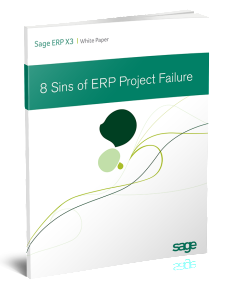Considering a New ERP Implementation? Learn 4 ERP System Basics
ERP Implementation: 4 ERP Basics Before Starting Your Project As ERP implementation specialist and ERP consultants, we help clients who deal with...
4 min read
Richard Cushing Tue, Dec 23, 2014

There are countless horror stories about ERP implementations turning into runaway expensive, longer than expected projects. This fear of the unknown is a major reason many companies prolong changing their ERP system. After all, change and the fear of the unknown are very scary propositions for most human beings. Over the years, we have worked with small to mid-sized business enterprises in a number of different industries to help them with a smooth transition into their new ERP system. If your current business is struggling with outdated systems and it’s time for a change, let’s see what can be learned from a successful business like Toyota to ensure your ERP implementation success.
In our experience we have been trying to make the point with our clients that everyone in the business–from the production floor all the way down to the CEO–should be involved in a new ERP selection with a thorough needs analysis. This removes much of the risk of unexpected delays and costs once you get started with the ERP implementation process. If you empower your staff as stakeholders in the process and put them in a role of “business strategist,” this will increase your ERP implementation success and adoption of your new ERP system.
Let’s look at Toyota and how they accomplished success to illustrate how empowering your employees in the role of the “business strategist” will help with a successful ERP project. Hopefully, you will find ways like Toyota to help your own company make more money tomorrow than it’s making today with a successful ERP implementation!
Every business who makes a decision to invest in a new ERP system and undergo an ERP implementation is anxious to realize the return on investment (R.O.I.). This is what most smart business owners and investors are after, we think. ERP systems are supposed to make your business more efficient and profitable after all. Let’s do more than just hope your ERP implementation goes smoothly so you start to see those profits sooner than later.
Few enterprises anywhere in the world have been more consistent or more successful at producing profits in good times and not-so-good times than Toyota. They have achieved success that dwarfs the Big Three automakers in the U.S.
Since sometime in the 1980s, Toyota’s market capitalization has been more than the sum of the market capitalization of the U.S. Big Three combined. Furthermore, for more than three decades, Toyota has produced profits with consistency while the Big Three in the U.S. have had extremely unstable profits and eroding capital over the same period of time.
How has Toyota achieved this stability and success?
Your ERP Implementation Needs Assessment Includes All Key Stakeholders: As with most things, there are many factors involved in Toyota’s success. Toyota places high value on the input managers and executives received from their production-line workers. Workers are encouraged to innovate and find ways to eliminate any work effort that does not add value to the product being delivered to the customer.
Toyota managers and executives firmly believe that no one knows more about the machine–any machine or any system–than the one who “runs” the machine. Workers in the Toyota Production System (TPS), whether implemented in Japan or in U.S. plants, are encouraged to stop production and call for an immediate review by managers and team members whenever they identify something unusual-a deviation from the standard—that affects the flow or work. (It is a fiction that such stoppages halt the work throughout the plant. Typically such stoppages only affect a small portion of the whole plant, unless the stoppage lasts more than a few minutes or, in some cases, up to several hours.)
The goal, in the TPS “meeting” that occurs when a worker halts production, is not “firefighting” to get things running again–as it is in most U.S. facilities. Instead, the focus is two essential matters: 1) identifying as quickly as possible what went wrong at the ‘root’ of the problem, and 2) figuring out what steps should be taken to prevent such an occurrence ever again.
This calls for the quickly assembled team of managers and production workers to become “business strategists” in the very best sense of the term. They must think, not tactically about how to put the “fire” out, but strategically about what steps should be taken–or, at least, initiated–to assure that quality remains undiminished and the flow of product to their customers is not stopped (or even slowed) by such occurrences.
What is the ultimate focus of every worker or manager participating in the team that assembles to see what went wrong?
Throughput.
The continuous flow of product from raw materials to finished product through many value-added steps with as little waste as possible through non-value-added activity.
THE RESULT
What is the result for Toyota?
Toyota is able to produce a greater variety of products with higher quality and at lower cost than its competitors. It is able to bring new models from the drawing board to production in far shorter time than any of its U.S. or European competitors. And the workers on the line have a better sense of who their customers are and what their customers desire in product and experience of ownership than any of the line workers at the Big Three here in the U.S.
This demonstrates clearly, in my mind, how the Toyota Way makes every employee a “business strategist,” and how doing so produces better and more consistent products–not just year after year, but decade after decade. Most U.S. companies can only dream of such stability and success.
We are convinced that, when we help small to mid-sized business enterprises begin to apply these same principles to their ERP implementation and beyond they will begin to create for themselves a process of ongoing improvement (POOGI). These companies who we help undergo a successful ERP implementation will become more stable and more successful.
Additionally, if these firms will work extend these practices up and down their supply chains, their supply chains will similarly experience greater stability, lower risk, higher profits and improved ability to bring products to market faster than competing supply chains in their industries.
So, don’t stop at turning your CIO into a “business strategist.” With just the ERP implementation. Take steps beginning today to make everyone in your enterprise a “business strategist.” Get them all involved in reducing risk, improving throughput, and help your profits increase and stabilize.
We would be delighted to hear your thoughts on this topic. Please leave your comments here, or feel free to contact us directly if you’d prefer.

ERP Implementation: 4 ERP Basics Before Starting Your Project As ERP implementation specialist and ERP consultants, we help clients who deal with...

1 min read
ERP Implementation Tips: 2 Common Mistakes Implementing an enterprise resource planning software system is often the first step for companies that...

ERP Implementation Consultant: The Rise of the Cloud & Excel-Based Reporting Tools If you have undergone an ERP implementation over the last decade,...